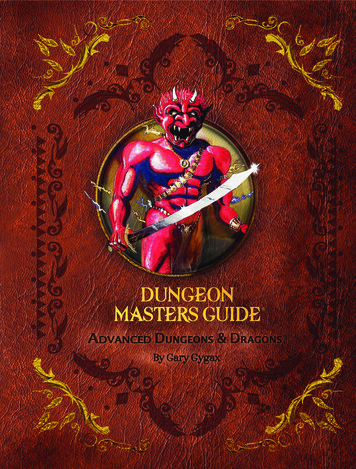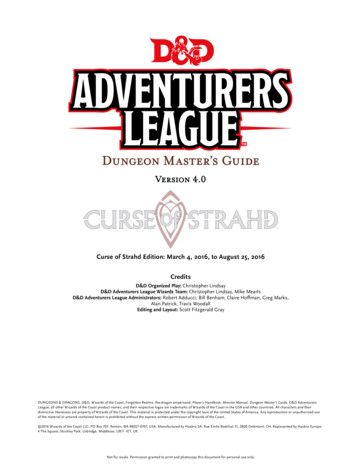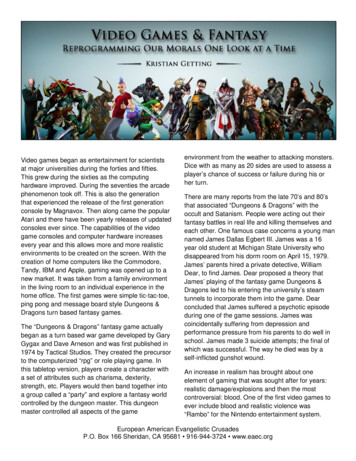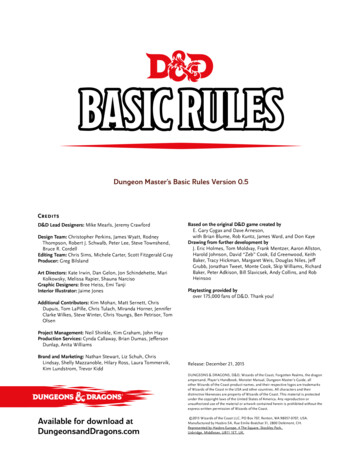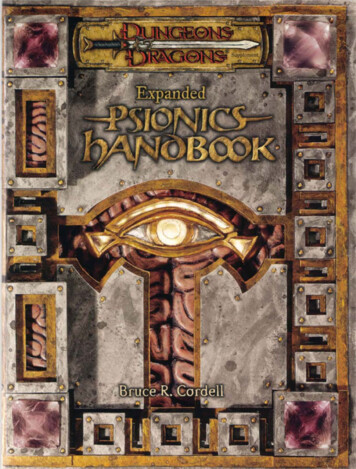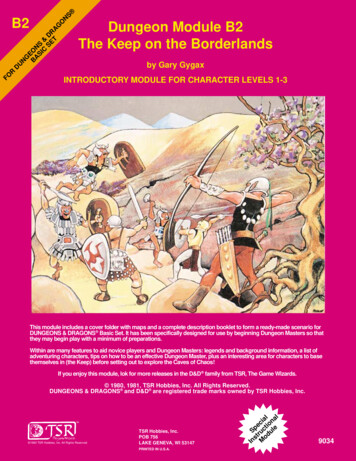
Transcription
NS ODungeon Module B2The Keep on the Borderlandsby Gary GygaxFORDUNGEB OA NSI SC &SE DT RAGB2INTRODUCTORY MODULE FOR CHARACTER LEVELS 1-3This module includes a cover folder with maps and a complete description booklet to form a ready-made scenario forDUNGEONS & DRAGONS Basic Set. It has been specifically designed for use by beginning Dungeon Masters so thatthey may begin play with a minimum of preparations.Within are many features to aid novice players and Dungeon Masters: legends and background information, a list ofadventuring characters, tips on how to be an effective Dungeon Master, plus an interesting area for characters to basethemselves in (the Keep) before setting out to explore the Caves of Chaos!If you enjoy this module, lok for more releases in the D&D family from TSR, The Game Wizards. 1980, 1981, TSR Hobbies, Inc. All Rights Reserved.DUNGEONS & DRAGONS and D&D are registered trade marks owned by TSR Hobbies, Inc. 1980 TSR Hobbies, Inc. All Rights ReservedTSR Hobbies, Inc.POB 756LAKE GENEVA, WI 53147PRINTED IN U.S.A.l lia nace tio eSp ruc ulst odIn M9034
Dungeon Module B2The Keep on the Borderlandsby Gary GygaxINTRODUCTORY MODULE FOR CHARACTER LEVELS1-3This module includes a cover folder with maps and a complete description booklet to form a ready-made scenario forDUNGEONS & DRAGONS@ Basic Set. It hus been specially designed for use by beginning Dungeon Musters so that theymuy begin play with a minimum of preparations.Within are muny features to aid novice players and Dungeon Musters: legends, history and background information, a listof adventuringcharacters, tips on how to be an effective Dungeon Muster, plus on interesting area for characters to basethemselves in (the Keep) before setting out to explore the Caves of Chuos!If you enjoy this module, look for more releases in the D&D@ family from TSR, The Gume Wizards.Distributed to the book trade in the United States by Random House, Inc. and in Canada by Random Houseof Canada, Ltd. Distributed to the toy and hobby trade by regional distributors.C 1981 by TSR Hobbies, Inc., All Rights Reserved.DUNGEONS & DRAGONS@ and D&D@ are registered trademarks owned by TSR Hobbies, Inc.TSR Hobbies, Inc.POB 756LAKE GENEVA, WI 53147PRINTED IN U.S.A.ISBN 0-935696-47-4
acters are to adventure, be sure to have a non-player character or two go along, as well as a few men-at-arms. In addition, give the player characters a magic dagger or somemagic arrows and at least one potion of healing - familybequests to aid them in finding their fame and fortunewhen they go against Chaos.Dungeons & DragonsDungeon Module #B2The Keep on the BorderlandsIntroduction: Welcome to the land of imagination. You areThe DM should be careful to give the player characters areasonable chance to survive. If your players tend to berash and unthinking, it might be better to allow them tohave a few men-at-arms accompany them even if the partyis large, and they don’t attempt to hire such mercenaries*.Hopefully, they will quickly learn that the monsters here willwork together and attack intelligently, if able. If this lesson isnot learned, all that can be done is to allow the chips to fallwhere they may. Dead characters cannot be brought backto life here!Using the KEEP as “home base”, your players should beable to have quite a number of adventures (playingsessions) before they have exhausted all the possibilities ofthe Caves of Chaos map. Assuming that they have playedwell, their player characters will certainly have advanceda level or two in experience when the last minion of darkness falls before their might. While your players will haveadvanced in their understanding and ability, you will likewise have increased your skills as DM. In fact, before theyhave finished all the adventure areas of this module, it islikely that you will have begun to add your own separatemaps to the setting. The KEEP is only a small section of theworld. You must build the towns and terrain which surroundit. You must shape the societies, create the kingdoms, andpopulate the countryside with men and monsters.about to begin a journey into worlds where magic andmonsters are the order of the day, where law and chaosare forever at odds, where adventure and heroism are themeat and drink of all who would seek their fortunes in uncommon pursuits. This is the realm of DUNGEONS &DRAGONS@ Adventure Game.If you plan to play in this module and participate in the funof adventuring, stop reading now. The information in therest of the module is for your Dungeon Master or DM, so thathe or she may guide you and other players through a thrilling adventure. Knowing too much about the contents of thismodule will spoil the surprises and excitement of the game.Dungeon Masters, if many copies of this module are available to the players, you may wish to alter sections of theKeep and the Caves of Chaos. If you do this, you will be sureto have new surprises for players who might be familiar withsome of the contents of the module. You are not enteringthis world in the usual manner, for you are setting forth to bea Dungeon Master. Certainly there are stout fighters,mighty magic-users, wily thieves, and courageous clericswho will make their mark in the magical lands of D&D@adventure. You, however, are above even the greatest ofthese, for as DM you are to become the Shaper of theCosmos. It is you who will give form and content to all theuniverse. You will breathe life into the stillness, giving meaning and purpose to all the actions which are to follow. Theothers in your group will assume the roles of individuals andplay their parts, but each can only perform within thebounds you will set. It is now up to you to create a magicalrealm filled with danger, mystery, and excitement, complete with countless challenges. Though your role is thegreatest, it is also the most difficult. You must now prepareto become all things to all people.The KEEP is a microcosm, a world in miniature. Within itswalls your players will find what is basically a small villagewith a social order, and will meet opponents of a sort. Outside lies the way to the Caves of Chaos where monstersabound. As you build the campaign setting, you can usethis module as a guide. Humankind and its allies have established strongholds - whether fortresses or organizedcountries - where the players’ characters will base themselves, interact with the society, and occasionally encounter foes of one sort or another. Surrounding thesestrongholds are lands which may be hostile to the bold adventurers. Perhaps there are areas of wilderness filled withdangerous creatures, or maybe the neighboring area is aland where chaos and evil rule (for wilderness adventures,see DUNGEONS & DRAGONS@ EXPERT SET). There are naturalobstacles to consider, such as mountains, marshes, deserts,and seas. There can also be magical barriers, protections,and portals. Anything you can imagine could be part ofyour world if you so desire. The challenge to your imagination is to make a world which will bring the ultimate in fabulous and fantastic adventure to your players. A world whichthey may believe in.NOTES FOR THE DUNGEON MASTERThe basic instruction book for DUNGEONS & DRAGONS@Game has given you the information necessary to understand this game and start play. This module is another tool.It is a scenario or setting which will help you to understandthe fine art of being a Dungeon Master as you introduceyour group of players to your own fantasy world, your interpretation of the many worlds of DUNGEONS & DRAGONS@Adventure. THE KEEP ON THE BORDERLANDS is simply offered for your use as a way to move smoothly and rapidlyinto your own special continuing adventures or campaigns. Read the module thoroughly; you will notice thatthe details are left in your hands. This allows you to personalize the scenario, and suit it to what you and your playerswill find most enjoyable.NOTE: For your convenience, whenever a monster or non-player character (NPC*) is described in the text, the detailswill be listed in the following order:NOTE: Several words in the following text will be followed byan asterisk (*). This means that the word will be explained inthe Glossary at the end of this module.This module has been designed to allow six to nine playercharacters of first level to play out many adventures,gradually working up to second or third level of experiencein the process. The group is assumed to have at least onemagic-user and one cleric In It. If you have fewer than sixplayers, be sure to arrange for them to get both advice andhelp in the KEEP. For example, they should have advicefrom a friendly individual to “stay near the beginning of theravine area, and enter the lower caves first”, to avoid theirgetting into immediate trouble with higher level monsters.Likewise, the services of several men-at-arms* must beavailable to smaller parties, If only two or three player char-Name (Armor Class, Class/Level or Hit Dice, hit points, Number of Attacks per round, Damage per attack, Movement (per round), Save as class and level, Morale)Armor Class AC; Class: Cleric C, Fighter F, Magicuser M, Thief T, Dwarf D, Elf E, Halfling H, NormalMan LVL 0 or NM; Level #, Hit Dice HD, hit points hp, Number of Attacks #AT, Damage D, Movement MV, Save Save, Morale ML.Class/level is only used for non-player characters (NPCs),while Hit Dice is used for all other monsters. Movement in agame turn is three times the movement given for one combat round. NPCs save at the same level as their class levelof experience.2
When dice are used to randomly determine a number, thetype of dice used are abbreviated ‘d#’ (‘d4’ means a foursided die, ‘d6’ a six-sided, and so forth). If more than one isrolled, the number required is placed before the ‘d’ (‘2d6’means two six-sided dice). If any number is to be added tothe total of the dice, it is indicated afterward (‘d4 2’ meansto roll a four-sided die and add 2 to the total: ‘2d8 1’ willthus give a number from 3 to 17). You will quickly get toknow all of these abbreviations, and may use them whenyou design your own dungeon.Examples: Taverner (AC 9, LVL 0, hp 6, #AT I, D 1-6, ML 8)Guard (AC 4, F 1, hp 7, #AT 1, D 1-6, ML 10)Kobold (AC 7, HD V2, hp 3, #AT 1, D 1-4, MV (40’)Save NM, ML 6)#AT l/2 indicates that the player may only attack onceevery 2 rounds.An asterisk after Hit Dice indicates an experience pointbonus.* * Two asterisks after Hit Dice indicates double the normalexperience point bonus.lBecome familiar with this module, then make whatever additions or changes you feel are necessary for your campaign. Once you are satisfied, gather the players togetherand have them create their characters. This will take sometime, so at first, don’t plan on getting much playing doneunless there is a lot of time available. After each person hasrolled the numbers for his or her characteristics (Strength,Intelligence, etc.), selected a class, and found how muchmoney he or she has to begin, you should introduce themto the setting by reading the Background section to them. Ifyou wish, feel free to limit the classes your players maychoose as suits your setting. You might wish not to haveelves or halflings in the KEEP, or you might not want anythieves as beginning characters. It is all up to you as DM todecide the shape of the campaign. Likewise, you can optto give the player characters a special item of equipmentto begin with - possibly mules, a weapon, some tradegoods, or virtually anything of small value (within reason).Determining Armor Class:Armor ClassType of Armor9;:4i1NoneShield onlyLeatherLeather&ShieldChainmailChainmail &ShieldPlate MailPlate Mail &ShieldPlate Mail & magic Shield 1 (or othercombinations)Note that an Armor Class (AC) of less than 2 is possible forcharacters wearing magic armor, carrying a magic shield,having a higher than normal Dexterity score, and/or wearing a ring of protection. Players using these items will subtract bonuses from their AC - for example, a fighter usingboth Plate Mail 1 and Shield 1 would have AC 0.After you have explained the background, allow yourplayers to begin interacting with their characters. Givethem time to wander around the KEEP, learning what isthere, finding the limits of their freedom, and meeting theother “inhabitants” of the place. They may quickly establish their base in the Traveler’s Inn, purchase their equipment, and then visit the tavern - where they may gatherbits of information for their coming adventures. All of thisplay, as well as what will come afterwards, requires that theplayers play the personae (personalities) of the charactersthat they will have throughout the length of the campaign,much like an actor plays a role in a play. You, however,have a far greater challenge and obligation! You not onlymust order and create the world, you must also play thepart of each and every creature that the player charactersencounter. You must be gate guard and merchant, innkeeper and orc oracle and madman as the situation dictates. The role of DM is all-powerful, but it also makes manydemands. It is difficult to properly play the village idiot atone moment and the wise man the next, the noble clergyman on one hand and the vile monster on the other. In onerole you must be cooperative, in the next uncaring andnon-commital, then foolish, then clever, and so on. Be prepared!Using the Combat Tables:To find the die roll needed to hit any Armor Class, look atthe HOW TO ATTACK section in the D & D Basic Set rulebook. Compare the Level (if a character) or Hit Dice (if amonster) with the AC of the target to find the numberneeded ‘to hit’. For Armor Classes lower than 2, adjust thenumber upwards; a character needing a roll of 17 to hitAC 2 would need an 18 to hit AC I, 19 to hit AC 0, and soforth. Unless magic or silver weapons are needed to causedamage (and not available), a roll of 20 will always hit,and a roll of 1 will always miss!A bonus of 1 should be added to the “to hit” die roll ofhigh level characters, for they have more training and experience in fighting. This bonus will apply to Fighters of 4thlevel or above, to Clerics and Thieves of 5th level or above,and to Magic-Users of 6th level or above.Whether the first time you play or the next, the players willset forth to find and explore the many Caves of Chaos. Youmust describe the journey to the place and what the characters see, and allow them to choose how they will goabout their adventuring. In such situations, the DM must bea truly disinterested party, giving information as requiredby questioning and proper action, but neither helping norhindering otherwise. When the players experience their firstencounter with a monster, you must be ready to play thepart fully. If the monster is basically unintelligent, you musthave it act accordingly. Make the encounter exciting withthe proper dramatics of the animal sort - including noises!If the encounter is with an intelligent monster, it is up to theDM to not only provide an exciting description but also tocorrectly act the part of the monster. Rats, for instance, willswarm chitteringly from their burrows - a wave of liceridden hunger seeking to overrun the adventurers withsheer numbers, but easily driven off squealing with blowsand fire. Goblins, on the other hand, will skulk and hide inMovement in Combat:Combat movement is usually very short and quick. In acombat situation, only short charges or retreats are allowed. After combat is resolved, movement rates return tonormal. The movement speed for characters is:Unarmored, unencumbered man:Metal armored or encumbered man:Metal armored, encumbered man:40 feet permelee round20 feet permelee round10 feet permelee roundTo determine a monster’s movement speed in combat,divide its base movement speed by 3.Note: Movement speed may be different if the optional encumbrance rule is used.3
fore, it is important that the DM give accurate information,but the choice of action is the players’ decision.order to ambush and trap the party - fleeing from morepowerful foes, but always ready to set a new snare for theunwary character.Throughout all this - making decisions, playing roles,handling monsters - the DM must remember that he or sheis in control. The DM is the judge, and it is his or her game./The DM should listen to the players and weigh their arguments fairly when disagreements arise, but the final decision belongs to the DM. The Dungeon Master’s word is law!If all of this seems too difficult, never fear! Just as yourplayers are learning and gaining experience at D&D@play, so too will you be improving your ability as a DM. Thework necessary to become a master at the art is great, fargreater than that necessary to be a top player, but the rewards are even greater. You will bring untold enjoyment tomany players in your role as DM, and all the while you willhave the opportunity to exercise your imagination andcreative ability to the fullest. May each of your dungeonadventure episodes always be a wondrous experience!TIMEThe Dungeon Master is responsible for keeping a track ofgame time. Inside the dungeon, a normal turn is tenminutes long (adventure time). A normal turn is determinedby the distance the slowest party member can travel, usingthe CHARACTER MOVEMENT TABLE in the Dungeons &Dragons Basic Set rulebook. For example, a party whoseslowest member moves at 120feet per turn, would travel 120feet in a turn. When the party has mapped 120 feet of dungeon, one turn has passed.lf fighting should occur, the time reference shifts to meleerounds of 10 seconds each. Melee rounds are used to simulate the quick exchange of blows in combat. For convenience, a DM should consider one entire melee* to lastlong as one normal turn (that is, 10 minutes), no matter howmany melee rounds the combat actually took. The extratime is spent recovering one’s breath, bandaging wounds,resharpening blunted weapons, etc.HOW TO BE AN EFFECTIVE DUNGEON MASTERAs Dungeon Master, the beginner is faced with a difficultproblem. The DM is the most important person in the D&D@game. He or she sets up and controls all situations, makesdecisions, and acts as the link between the players and theworld he or she has created. Perhaps the most commonquestion asked by a beginning Dungeon Master is, “Whatdo I do to run a game?” It is possible to read through therules and become slightly lost by all the things that must beprepared or known before DMing a game.Unlike most boardgames, D&D play relies on information,both from the players and the DM. In boardgames, the waythe game is played is obvious. First one person moves, andthen another. Actions are limited and choices are few. Inthis game, the action is only limited by the abilities of thecharacter, the imagination of the player, and the decisionsof the DM. The play will often go in unexpected directionsand the DM will sometimes be required to decide on situations not covered in the rules. The DM is the judge.The actual (clock-time) length of a turn varies. A turn mighttake longer than ten actual minutes, especially if a longcombat has taken place. On the other hand, a turn may bequite short in actual time, if the party is heading backthrough a familiar area.In general, a party should rest and sleep eight hours every24. Cautious player characters will sleep in shifts, with aguard always awake.Remember that player characters heal 1-3 points naturallyevery 24 hours of full rest.As a judge, moderator, or referee, the DM must constantlydeal with the players. Just as the referee of a sporting event,the DM must be fair. He or she cannot be “out to get theplayers”, nor should he or she be on their side all the time.The DM must be neutral. If a party has played well andsucceeded, the DM should not punish them by sendingmore and more monsters at them or thwart their plans; onthe other hand, if the players have acted foolishly, theyshould get their “just rewards”. In combat, the DM shouldplay the monsters to the best of the monster’s ability. If thecreature is stupid, it may be easily tricked or may not always do the smartest thing. If the monster is clever or intelligent, it will fight to its best advantage. The DM must be fair,but the players must play wisely.DIVIDING TREASURE AND COMPUTING EXPERIENCEAfter the party leaves the dungeon safely, all survivingplayer characters should divide the treasure and beawarded their experience points. Division of treasure is theplayers’ responsibility. Awarding experience points is theDungeon Master’s responsibility.Ideally, treasure should be divided equally among surviving player characters, with retainers* usually receiving ashare (minus any advance payment already given them).Players may decide to only give magical items to character classes that could use them. For example, a fightershould take a magical sword as part of his or her share inpreference to a scroll.The DM is also the designer of the situations and must bearin mind the abilities of his or her players. It is the job of theDM to see that the situations and characters balance. Ifthings are too difficult, the players will become discouraged; too easy and they will become bored. Is it possible for a good player to win, yet still be a challenge and arisk in doing so? Is the amount of treasure gained equal tothe danger of trying to get it? As DM, much satisfactioncomes from watching players overcome a difficult situation. But they should do it on their own!Non-magical treasure is usually divided first, since it iseasier to divide equally. It is seldom possible to dividemagic items equally. A suggested solution to division ofmagic items is to have each character roll percentile diceand let the highest score have first pick, second highestscore second pick, and so on until there are no moremagical items. Retainers may, or may not, be given anequal chance for a magic item. If they are excluded, a DMshould note the fact and take it into account when it nextcomes time to test the retainers’ loyalty.To defeat monsters and overcome problems, the DM mustbe a dispenser of information. Again, he or she must be fair- telling the party what it can see, but not what it cannot.Questions will be asked by players, either of the DM or ofsome character the party has encountered, and the DMmust decide what to say. Information should never begiven away that the characters have not found out secret doors may be missed, treasure or magic items overlooked, or the wrong question asked of a townsperson. Theplayers must be allowed to make their own choices. There-For example, a party consisting of a fighter, a magic-user,and a retainer (all first level) returns safely to the Keep. Theirrecovered treasure equals 520 gold pieces, 1000 silverpieces, a necklace worth 400 gold pieces, a sword I anda ring of water walking. The total value of all non-magicaltreasure is 1020 gold pieces. Without selling the necklace, itwould be impossible for the party to split the treasure4
equally. The two player characters compromise by givingthe necklace to their retainer, to insure his loyalty with agreater share of treasure. They each take only 310 goldpieces, but the magic-user keeps the ring and the fighterkeeps the sword.Experience points are awarded by the DM to playercharacters on the basis of non-magical treasure recoveredand monsters killed or overcome. Experience points forrecovered treasure are calculated at one experiencepoint for every gold piece worth of non-magical treasure.Experience points for monsters overcome or killed iscalculated by using the Experience Points for Monsterschart in the DUNGEONS & DRAGONS Basic Set rulebook.Unless a player character has earned extra treasurethrough the use of his or her class abilities (for example, athief who steals treasure which he did not report to theparty), the DM should divide the experience pointsPREPARATION FOR THE USE OF THE MODULEThe use of this module first requires that the DM be familiarwith its contents. Therefore, the first step is to completelyread through the module, referring to the maps provided tolearn the locations of the various features. A second (andthird!) reading will be helpful in learning the nature of themonsters, their methods of attack and defense, and thetreasures guarded.Certain buildings of the KEEP will frequently be visited bythe adventurers (such as the Travelers Inn, Tavern, and Provisioner). Floor plans are very useful in visualizing theseareas. For information on their preparation, refer to the section entitled “Designing Floor Plans” near the end of themodule.Once you are familiar with the areas described in themodule and have drawn whatever additional plans youwish, assist the players in preparing their characters byreading them the section entitled Background. This will setthe stage for the game.After the background is given, the players may preparetheir characters. Full details are given in the D & D BASICSET rulebook. A written record of each character should bekept by the players.earned through treasure recovery equally among all surviving party members. Since, in the above example, theentire party recovered 1020 gold pieces worth of nonmagical treasure, the fighter and the magic-user each receive 340 experience points for the treasure recovered. Theretainer receives 1/2 normal experience, since he was onlyfollowing orders, and not doing his own thinking. The retainer thus receives only 170 experience points for recovered treasure.As an alternative to rolling up new characters, the playersmay (at the DM’s option) select characters from the NPC*list in this module. Note that the personalities given are forthe DM’s use with NPC’s only, and are not to be used by theplayers.To recover the treasure, it was necessary for the party members to kill 19 orcs, 7 skeletons, and an ogre. The partyshould receive 10 points of experience for each orc killed,as orcs have 1 hit die. The party should receive 5 experience points for each skeleton. For killing the ogre, theyshould receive 125 experience points, since it has 4 1 hitdice. The total experience points for defeating monsterswould be 350. When this is divided, the magic-user andfighter each receive 117 additional experience points. Theretainer receives only one-half, 59 additional experiencepoints. The total experience for each player character is457 (340 117) experience points apiece. The retainer receives 229 experience points.Before the Players enter the KEEP, the DM may privately giveeach Player one rumor about the CAVES OF CHAOS. This information may be shared or kept secret, as the playerswish. The DM should avoid interfering with their choiceswhatever the result. Additional information may begathered in the KEEP itself; use the Rumors Table in the “DMNotes About the Keep” for this purpose, or create your ownbased on the CAVES.To start an adventure outside the KEEP, the players must decide on an order of march - who will be in the first rank,middle, and at the rear of the party. This should be drawnon a sheet of paper and given to the DM for his or her reference. Any changes in the order (due to injuries, specialprocedures, etc.) should be noted on the sheet as theyoccur. In a standard 10’ wide corridor, the most commonarrangement is two adventurers, side by side, in each rank;however, three characters could occupy a single rank if allof their weapons were small (such as daggers and handaxes).When enough experience points are accumulated, aplayer character rises to the next higher level, and gainsthe benefits of that level (an additional hit die, a new spell,etc.). Wealth can be used to buy new equipment, to pay foreveryday expenses, and to hire retainers.One player in the group should be selected as leader and‘caller’ for the party; another one or two should take care ofnecessary mapping. INDIVIDUAL PLAYERS MAY DECIDE ONTHEIR ACTIONS, but it is the ‘caller’ who gives the DM the details on the party’s course of action (such as “We’ll headdown the eastern corridor.“). The caller should discuss theparty’s actions with the players, and inform the DM of thedecisions of the group. When a player speaks and indicates that an action is being taken, it has begun - evenif the player changes his mind. Use your discretion in thesecases, and remember that the DM has the final say in allmatters.The players should use graph paper to map the areasbeing explored. Have them indicate which direction isnorth, and use compass directions to describe details anddirection of travel (“We’ll go west and turn north at the nextintersection”). Use the same method to describe areas tothem (“You see a corridor which goes about 30’ south andthen turns west”). Be sure to keep your descriptions accurate, though you may say such things as ‘about fortyfeet’, especially in open areas or when describing irregular5
surfaces. Players will often show you their map and ask “ISthis right?” Do not correct their mistakes unless the errorwould be obvious in the eyes of the adventurers, and remember that, in most cases, maps do not have to be exact.Encourage good mapping skills and an attention to detail,and avoid falling into a rut of continually answering mapquestions.against the common foe. Now, before you enter the grimfortress, is the time for introductions and an exchange of information, for fate seems to have decreed that you are tobecome an adventurous band who must pass throughmany harrowing experiences together on the path whichleads towards greatness.Exploration of the CAVES OF CHAOS will take more than onegame session. When the players want to stop play, theymust find an exit and (preferably) return to the KEEP. Youmay divide treasure and award experience when thisoccurs. Remember to make adjustments to the areas theyvisited - the monsters may build new defenses, reoccupyareas that were cleaned out, and so forth.START:If the adventurers wish to stop exploring for a while andtake a rest period (for example, the customary 8 hours resteach night),
DUNGEONS & DRAGONS@ and D&D@ are registered trademarks owned by TSR Hobbies, Inc. TSR Hobbies, Inc. POB 756 LAKE GENEVA, WI 53147 PRINTED IN U.S.A. ISBN -935696-47-4. Dungeons & Dragons Dungeon Module #B2 The Keep on the Borderlands Introduction: Welcome to the land of imagination. You are

